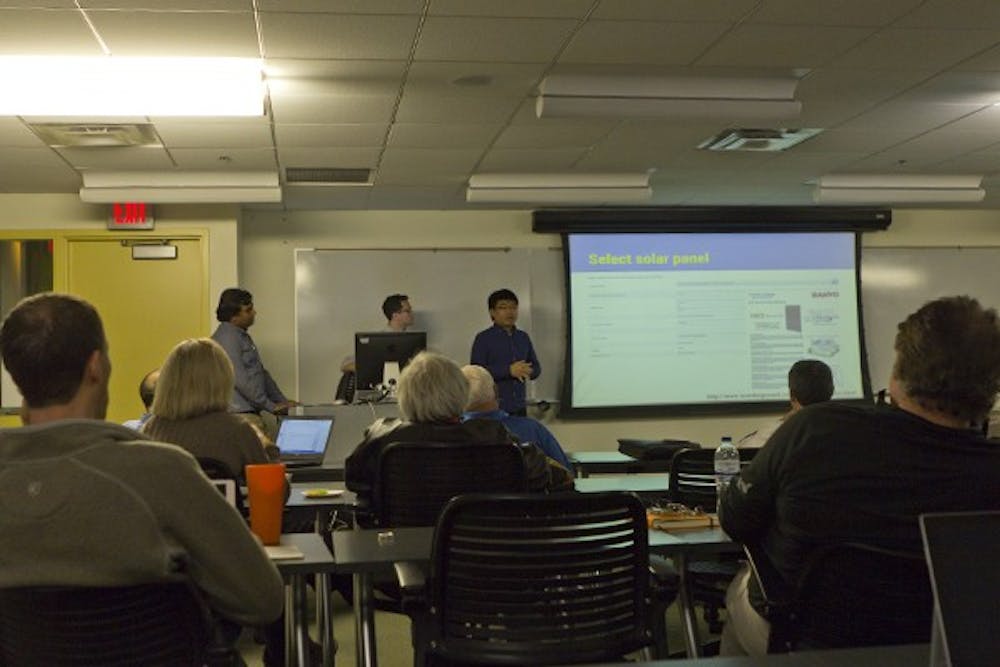 Senior sustainability scientist Mick Dalrymple poses at the School of Sustainability in Tempe in Dec. 1, 2014. Dalrymple taught the class that was launched this semester.? (Photo by Emily Johnson)
Senior sustainability scientist Mick Dalrymple poses at the School of Sustainability in Tempe in Dec. 1, 2014. Dalrymple taught the class that was launched this semester.? (Photo by Emily Johnson)
A new course offered by the ASU School of Sustainability focuses on the Living Building Challenge, which is the idea of a building that functions like a flower — meaning it must produce energy and capture water.
Creating Living Building, taught by ASU professors Mick Dalrymple and Oswald Chong, both ASU professors, was launched this semester after supporters provided funding.
Dalrymple said the City of Phoenix Public Works Department contributed expertise and resources once they decided to use the city-owned Resource Innovation and Solutions Network campus as the main focus of the course.
“The course aims to help the students learn the principles of Living Buildings through expert guest speakers and by applying those principles through integrated teamwork on real, intriguing building projects and challenges,” Dalrymple said.
He said he has seen the students receive benefits beyond those that stem from helping improve projects being built in the community.
 Graduate students showcase their presentations to a large group of people at the School of Sustainability on Dec. 1, 2014. These students present their proposals for Phoenix's Resource Innovation and Solutions Network (RISN).? (Photo by Emily Johnson)
Graduate students showcase their presentations to a large group of people at the School of Sustainability on Dec. 1, 2014. These students present their proposals for Phoenix's Resource Innovation and Solutions Network (RISN).? (Photo by Emily Johnson)
“I have seen students gain an appreciation for the complexities of applying theoretical concepts to actual projects that don’t run on semester time,” Dalrymple said. “They also better understand the people factor in solving sustainability challenges.”
The Liberty Wildlife Foundation gave students an opportunity to use what they learned when they asked students to explore opportunities to reduce the municipal water needs of their new facility.
“Students analyzed all possible sources and uses of water to create a water budget,” he said. “They then researched technology and design options to reduce consumption, maximize rainwater capture, and treat and reuse water to get as close to zero net water as possible. The Liberty Wildfire Foundation was very impressed with the students’ recommendations and is incorporating several of them into the building and site design.”
This semester’s class is intended to lead into next spring’s class, which will let students participate in creating the conceptual design for the Resource Innovation and Solutions Network headquarters building, Dalrymple said.
Graduate student Haley Gilles said she came into the class with an open mind and has been pleasantly surprised thus far.
“I could not have expected to be able to work so closely with the city of Phoenix Public Works Department, which has opened my eyes to a whole new government sector,” she said.
Although it has been difficult, she said it is the most amazing course she has ever taken.
“We were thrown into projects with high expectations, and we had no idea how much fun we were going to have,” Gilles said.
Graduate student Caitlin Seppi, another student in the course, said Creating Living Buildings is considerably different than her other classes.
“It is a project-based class taken by an interesting group of students from different academic backgrounds,” she said. “Along with having professionals come to class and give us practical advice about our work, working with students from different backgrounds is heavily stressed in the School of Sustainability, so it’s nice to get that experience.”
CORRECTION: Due to a reporting error, a previous version of this article incorrectly stated the name of the Liberty Wildlife Foundation. This version has been updated with the proper name.
Reach the reporter at Justin.Toscano@asu.edu or follow him on Twitter @justintoscano3.
Like The State Press on Facebook and follow @statepress on Twitter




